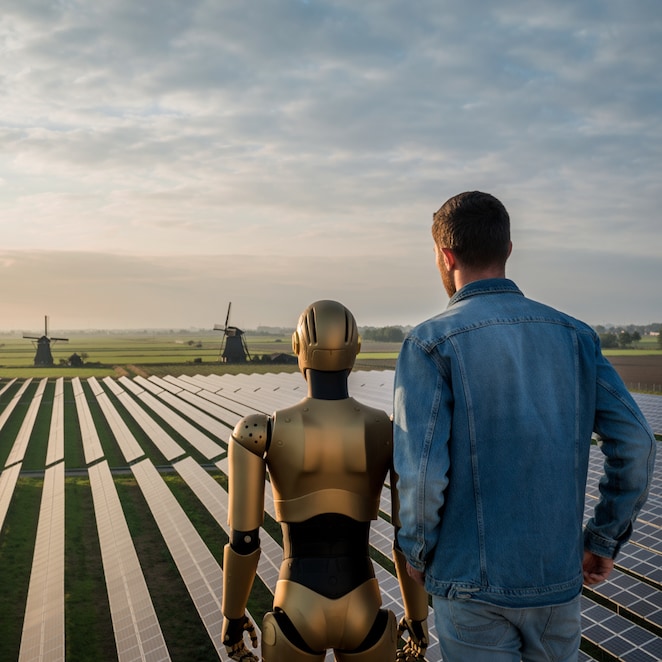
Shell Venster
Ooit papier, nu digitaal, altijd inzichtelijk. Venster verrijkt je kennis en verruimt je blik over de ontwikkelingen in de energiewereld en bij Shell.

Afschakelen
Het waait zó hard dat windmolens volop stroom kunnen produceren. Maar… in de stroombehoefte is ruimschoots voorzien en de turbines kunnen hun stroom niet kwijt. Ook kan de stroom kan nog niet worden opgeslagen. Dan worden windmolens afgeschakeld. Afschakelen is Vensters woord van de maand november.

Carrière in Shell: wat als je doof bent?
3 december: Internationale Dag voor Personen met een Beperking | Stefan de Visser is doof. En toch werkt hij bij Shell Pernis in de Centrale Werkplaats, met draaiende machines en bewegende delen. Als opgeleid onderhoudswerktuigbouwkundige reviseert hij pompen en compressors. Terwijl veel bedrijven huiverig zijn voor alleen al het bieden van een stageplaats aan een dove bankwerker, kreeg Stefan bij Shell Pernis wel een kans.
Venster-editie 11-2025: November

Zo ziet de productie van groene waterstof er van binnen uit
Waterstoffabriek Holland Hydrogen 1 laat zich niet direct vinden, zo tussen de talrijke vierkante logistieke gebouwen aan de rand van de Tweede Maasvlakte bij Rotterdam. Dat zit zo: deze fabriek líjkt helemaal niet op een fabriek in de traditionele zin van het woord. Holland Hydrogen 1 vertoont eerder gelijkenissen met haar logistieke buren. Wie binnenkijkt, weet beter! Een reportage.

Vier trends voor de energietoekomst van de industrie
In juli 2031 bereikt, als alles goed gaat, een Europese ruimtesonde de planeet Jupiter. Na een stille reis van acht jaar zal Jupiter Icy Moons Explorer (Juice) drie van de grootste manen van de gasreus onderzoeken op tekenen van leven1. Voor deze missie moesten wetenschappers al een decennium geleden beginnen met plannen, verschillende scenario’s doorlopen en zich voorbereiden op uitdagingen.

Oxford Economics Report
"Shells bijdrage Nederland onmiskenbaar"
Shells bijdrage aan de economie en energiezekerheid in Nederland waren ook in 2024 onmiskenbaar. Dat blijkt uit het nieuwste rapport over de sociaal-economische bijdrage van Shell in Nederland van economisch adviesbureau Oxford Economics. Shells belang is zichtbaar in tienduizenden banen, investeringen in de energietransitie en doorontwikkelingen van innovatieve technologieën, vaak samen met partners.

LeapSprong: krachten bundelen voor een duurzamere industrie
Innovatie, samenwerken, start-ups: de ideale ingrediënten voor vernieuwing. En die is hard nodig binnen een industriecluster dat nog grotendeels draait op fossiele brandstoffen, maar vastbesloten is om te verduurzamen. Acht start-ups staan in de startblokken om kansen te zoeken om de energietransitie in de regio Amsterdam te versnellen. Ze doen mee aan LeapSprong: een innovatieprogramma dat regionale uitdagingen in de energietransitie wil aanpakken.

Het getal 25
Natuurlijk, steeds meer automobilisten rijden inmiddels elektrisch, door veel bedrijven wordt hard gewerkt aan verduurzaming en ook de technologische ontwikkelingen staan niet stil. Maar toch, ’s werelds olie mag weliswaar de losbandige tienerjaren wel zijn ontgroeid, het verbruik zit volgens het IEA-“weersvoorspellers” nog niet in de nadagen van de levenscyclus.

Ruim miljard aan isolatiesubsidie blijft liggen: stichting heeft oplossing
Circa 640.000 huishoudens kampen met energiearmoede, zo blijkt uit cijfers van het Centraal Bureau voor de Statistiek. Het wel of niet investeren in verduurzamingsmaatregelen kan de verschillen tussen arm en rijk versterken. Experts pleiten daarom voor één duidelijk loket waar alle subsidies overzichtelijk en toegankelijk zijn. Stichting ISIE heeft hiervoor een oplossing gevonden, en dit wordt gesteund door het Shell Impact Fonds.

Nederlander lanceerde idee autosnelweg
Iemand moet toch ooit op dat briljante idee zijn gekomen: een weg zonder kruisingen, waarop je lekker kunt doorkarren. Misschien denk je daaraan terwijl je muurvast staat in een herfstfile op een van de 2474 kilometer snelweg die Nederland inmiddels telt. Het oorspronkelijke visioen – snelheid zonder obstakels – lijkt dan ver weg. Meer dan een eeuw geleden kwam het idee voor een autosnelweg opborrelen bij de bouwondernemer Salomon ten Bokkel Huinink.
Verdieping door het Venster

"Onstuimig, maar wind op zee is enorm competitief"
De offshore windsector heeft op dit moment wereldwijd flink wat tegenwind. En nu was het afgelopen zomer ook nog eens historisch windstil op de Noordzee. Hoe kijkt Jenneke Verhoef, Shells general manager Offshore Wind naar deze ontwikkelingen, terwijl voor windpark Hollandse Kust West bijna de eerste paal de zeebodem in gaat?

Hoe "Vikinggas" naar Nederland blijft stromen
Een bericht uit het land van Vikingen. Want, de kracht van eeuwen geleden spreekt nog altijd tot de verbeelding. Ook onder Shell-ingenieurs in Noorwegen die op grote diepte onder zee iets voor mekaar kregen wat nog nooit eerder is gebeurd. En dat helpt de grote Noorse gasstroom, ook naar Nederland, op gang te houden.

Dit is Jaap, commercieel operator bij Shells handelsorganisatie
Jaap Vroom is commercieel operator bij Shell en ontwikkelt zich in een tweejarig scholingstraject bij Trading and Supply. Dat is de handelstak van Shell die wereldwijd energie inkoopt, verkoopt en bij de klant aflevert. Jaap vertelt over zijn groei in de rol, de ondersteuning van collega’s, en hoe de brandende lichten van Shell Pernis hem inspireerde om te solliciteren.

De Beroepentuin slaat twee vliegen in één klap
Om een succesvolle energietransitie te realiseren, is er de komende twintig jaar een enorme opgave te verrichten. Door de vergrijzing en lage instroom blijft het vinden van vakmensen in de toekomst een uitdaging. Het innovatieve opleidingscentrum De Beroepentuin komt met een oplossing die twee vliegen in één klap slaat. Het Shell Impact Fonds steunt dit.

Racen op Shell Bitumen: "Zandvoort is een favoriet”
"Niets is vanzelfsprekend", zegt Jarno Zaffelli, een van 's werelds toonaangevende asfaltexperts voor racecircuits, oprichter en eigenaar van het Italiaanse Dromo Circuit Design. Zaffelli is een soort legende in de wereld van bitumen. Op basis van zijn expertise en oog voor detail kiezen beroemde racecircuits het asfalt dat bij hen past. Het circuit van Zandvoort is een van de klanten.

Woord van de maand oktober
Winterbenzine
Vanaf oktober tank je nét even andere benzine dan in de zomermaanden. Er komt namelijk winterbenzine uit de pomp. Winterbenzine is Vensters woord van de maand oktober.
Eerder in Venster

Interviews
Dit is Nikki, procesoperator op Moerdijk - grondstoffen maken voor alledaagse producten
Nikki de Laat is procesoperator bij Shell Chemicals Park Moerdijk. Een stage werd een vaste baan en nu wil ze graag de eerste vrouwelijke ploegleider worden op haar afdeling, die zich bezighoudt met chemische processen. “Shell biedt een werkomgeving waar iedereen zich welkom voelt.”
Talitha is onderhoudstechnicus bij Shell in Pernis
“Shell wilde graag meer vrouwen, dus werd mij gevraagd: zou je het leuk lijken om naar Shell te gaan? Tuurlijk, zei ik.” Talitha Marcus, is onderhoudstechnicus Hoogspanning en distributie bij Shell Energy and Chemicals Park Rotterdam in Pernis. “Wat ik doe is niet zomaar werk. Het is een kans om echt impact te maken.”
Aan het roer van de plek waar innovatieve energieoplossingen vandaan komen
“Dankbaarheid” en “een buitengewoon geschenk”. Zo beschrijft Sarah Street in dit 100-dageninterview haar gevoelens toen zij op 1 maart benoemd werd tot directeur van de Energy Transition Campus Amsterdam (ETCA). Ze staat aan het roer van de plek waar energieoplossingen voor vandaag en morgen samenkomen. Ze is in die rol niet de dirigent, maar de verbindende schakel in een tijd van transformatie.
Plastic recycling, een nieuwe weg
Wist je dat het plastic van je flesje water, de verpakking van je eten en het interieur van je auto niet altijd even gemakkelijk te recyclen valt? Hoe het dan wel kan, weet Paul de Hoog, business opportunity manager bij Shell.

Energietransitie
Groene waterstof in de Rotterdamse haven: het is maar hoe je het bekijkt
Met de bouw van de Holland Hydrogen 1-fabriek wordt in de Rotterdamse haven een enorme stap gezet in de ontwikkeling van groene waterstof. En tegelijkertijd ook nog maar een zeer bescheiden. Het is maar hoe je het bekijkt. Lydia Boktor, hoofdbeleidsmedewerker waterstof bij Shell Nederland en programmamanager waterstof Randolf Weterings van Havenbedrijf Rotterdam over het halflege én halfvolle glas van de waterstoftransitie. “Koplopers bouwen de duurste fabrieken.”
Shell Biogas en de Nederlandse ambities: grootste in groen gas dankzij Deens boerenverstand
Stel, je hebt een boerenbedrijf. Het rogge en tarwe van jouw land gaat in het brood dat mensen voedt. Maar het blad en de stengels van het gewas, daar kun je niet zo veel mee. Zie daar Shell Biogas, sinds september de nieuwe naam van het van oorsprong Deense Nature Energy. In Denemarken heeft biogas een lange traditie. In Nederland wat minder, maar ook in ons land wil Shell de komende jaren verder groeien met deze aardgasvervanger.
Het borrelt, bubbelt en bruist onder water bij Hollande Kust West
Dolfijnen zwemmen er, een zeepaardje is ontdekt en talrijke inktviseitjes zijn gevonden - op de onderzeese installaties voor het meten van geluid. Het zijn enkele van de ecologische verrassingen onder water in de voorbereidingen op de bouw van windpark Hollandse Kust West, Nederlands meest ecologische windpark tot nu toe.

Specials









